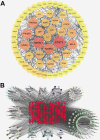Potential mechanism of action of Jing Fang Bai Du San in the treatment of COVID-19 using docking and network pharmacology
- PMID: 35165507
- PMCID: PMC8795796
- DOI: 10.7150/ijms.67116
Potential mechanism of action of Jing Fang Bai Du San in the treatment of COVID-19 using docking and network pharmacology
Abstract
Coronavirus disease 2019 (COVID-19), caused by severe acute respiratory syndrome coronavirus 2 (SARS-CoV-2), severely infects people and has rapidly spread worldwide. JingFangBaiDu San (JFBDS) has been used to treat prevalent epidemic pathogens, common cold, headache, cough due to lung-cold, and other symptoms; however, its treatment for COVID-19 is unknown. Molecular docking and network pharmacology were applied to obtain ingredient-protein structures and the herb-ingredient-disease target network model, respectively, to explore the potential mechanism of JFBDS in COVID-19 treatment. Network pharmacology analysis showed that acacetin, wogonin, and isorhamnetin were the main active ingredients of JFBDS, and EGFR, PIK3CA, LCK, MAPK1, MAPK3, MAPK8, STAT3, TNF, IL2, and RELA were speculated to be crucial therapeutic targets. Moreover, the Toll-like receptors, HIF-1, PIK3K/AKT, MAPK, NF-κB and NOD-like receptor signaling pathways were important for JFBDS in COVID-19 treatment. Molecular docking analysis indicated that ingredients of JFBDS could bind to angiotensin converting enzyme II, spike protein, and chymotrypsin like protease (3CLpro), which inhibits virus entry and replication in host cells. This study provides a new perspective for understanding potential therapeutic effects and mechanisms of JFBDS in COVID-19 and may facilitate its clinical application.
Keywords: COVID-19; JingFangBaiDu San; molecular docking; network pharmacology.
© The author(s).
Conflict of interest statement
Competing Interests: The authors have declared that no competing interest exists.
Figures





Similar articles
-
Network pharmacology and molecular docking analysis on molecular targets and mechanisms of Huashi Baidu formula in the treatment of COVID-19.Drug Dev Ind Pharm. 2020 Aug;46(8):1345-1353. doi: 10.1080/03639045.2020.1788070. Epub 2020 Jul 8. Drug Dev Ind Pharm. 2020. PMID: 32643448 Free PMC article.
-
A network pharmacology based approach for predicting active ingredients and potential mechanism of Lianhuaqingwen capsule in treating COVID-19.Int J Med Sci. 2021 Feb 24;18(8):1866-1876. doi: 10.7150/ijms.53685. eCollection 2021. Int J Med Sci. 2021. PMID: 33746604 Free PMC article.
-
Exploration of molecular targets and mechanisms of Chinese medicinal formula Acacia Catechu -Scutellariae Radix in the treatment of COVID-19 by a systems pharmacology strategy.Phytother Res. 2022 Nov;36(11):4210-4229. doi: 10.1002/ptr.7554. Epub 2022 Jul 20. Phytother Res. 2022. PMID: 35859316 Free PMC article.
-
Review on the potential action mechanisms of Chinese medicines in treating Coronavirus Disease 2019 (COVID-19).Pharmacol Res. 2020 Aug;158:104939. doi: 10.1016/j.phrs.2020.104939. Epub 2020 May 21. Pharmacol Res. 2020. PMID: 32445956 Free PMC article. Review.
-
Network pharmacology prediction and molecular docking-based strategy to explore the potential mechanism of Huanglian Jiedu Decoction against sepsis.Comput Biol Med. 2022 May;144:105389. doi: 10.1016/j.compbiomed.2022.105389. Epub 2022 Mar 9. Comput Biol Med. 2022. PMID: 35303581 Review.
Cited by
-
Active ingredients Isorhamnetin of Croci Srigma inhibit stomach adenocarcinomas progression by MAPK/mTOR signaling pathway.Sci Rep. 2023 Aug 3;13(1):12607. doi: 10.1038/s41598-023-39627-z. Sci Rep. 2023. PMID: 37537191 Free PMC article.
-
Therapeutic effects of herbal-medicine combined therapy for COVID-19: A systematic review and meta-analysis of randomized controlled trials.Front Pharmacol. 2022 Sep 1;13:950012. doi: 10.3389/fphar.2022.950012. eCollection 2022. Front Pharmacol. 2022. PMID: 36120361 Free PMC article.
-
Integrated bioinformatics and in silico approaches reveal the biological targets and molecular mechanisms of 1,25-dihydroxyvitamin D against COVID-19 and diabetes mellitus.Front Nutr. 2022 Dec 2;9:1060095. doi: 10.3389/fnut.2022.1060095. eCollection 2022. Front Nutr. 2022. PMID: 36532549 Free PMC article.
-
The Mechanism of Sijunzi Decoction Suppresses Gastric Cancer Metastasis via the m6A Methyltransferase METTL14 Based on Untargeted Metabolomics Studies and Network Pharmacology Analysis.Drug Des Devel Ther. 2025 Mar 31;19:2369-2392. doi: 10.2147/DDDT.S506702. eCollection 2025. Drug Des Devel Ther. 2025. PMID: 40190808 Free PMC article.
-
Efficacy analysis and research progress of complementary and alternative medicines in the adjuvant treatment of COVID-19.J Biomed Sci. 2023 May 3;30(1):30. doi: 10.1186/s12929-023-00923-5. J Biomed Sci. 2023. PMID: 37138292 Free PMC article. Review.
References
MeSH terms
LinkOut - more resources
Full Text Sources
Research Materials
Miscellaneous

